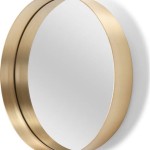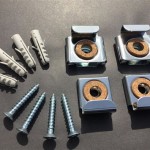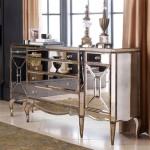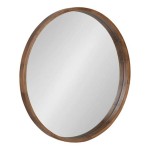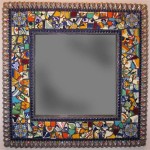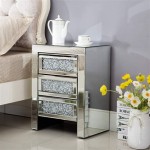How to Mount a Large Mirror Securely and Safely
Mounting a large mirror can dramatically enhance a room's aesthetic, creating an illusion of spaciousness and reflecting light. However, due to their weight and fragility, large mirrors require careful handling and secure mounting. This article details the process of safely and effectively mounting a large mirror on various wall surfaces.
Assess the Mirror and Wall
Before beginning, it's crucial to evaluate both the mirror and the wall where it will be hung. This assessment informs decisions regarding appropriate mounting hardware and techniques. Ignoring this step can lead to instability, damage to the wall, or even injury.
- Mirror Weight: Knowing the mirror's exact weight is essential for choosing hardware with sufficient load capacity. Check the manufacturer's specifications or weigh the mirror using a bathroom scale.
- Wall Type: Identify the wall material—drywall, plaster, concrete, or brick. Different wall types require specific fasteners and mounting methods. Use a stud finder to locate wall studs for added support, particularly with heavier mirrors.
- Mirror Backing: Examine the mirror's backing for existing mounting hardware, such as D-rings or wire. The type of backing influences the choice of mounting method.
Gather Necessary Tools and Materials
Having the correct tools and materials readily available streamlines the mounting process and ensures a smooth installation. Gathering everything beforehand prevents interruptions and potential mishaps.
- Measuring Tape: Accurate measurements are vital for proper placement and alignment.
- Level: Ensuring the mirror hangs straight is crucial for aesthetics and stability.
- Pencil: Marking the wall for drilling or fastener placement provides a guide for precise installation.
- Drill (with appropriate bits): Depending on the wall type, different drill bits will be required for pilot holes or anchoring.
- Screwdriver: For driving screws and securing mounting hardware.
- Wall Anchors (if necessary): Choose anchors appropriate for the wall type and the weight of the mirror.
- Mounting Hardware: Select heavy-duty D-rings, J-hooks, mirror clips, or a French cleat system based on the mirror's weight and backing.
- Safety Glasses: Protecting eyes from dust and debris is crucial during drilling and installation.
Choose the Right Mounting Hardware
The weight and size of the mirror dictate the appropriate mounting hardware. Opting for inadequate hardware can result in the mirror falling, potentially causing damage and injury.
- D-Rings and Wire: Suitable for lighter mirrors, this method involves attaching D-rings to the back of the mirror and hanging it from picture wire wrapped around hooks on the wall.
- J-Hooks: For medium-weight mirrors with pre-installed hanging hardware or a solid frame, J-hooks offer a sturdy mounting solution. Ensure the hooks are rated for the weight of the mirror.
- Mirror Clips: These clips grip the bottom and sides of the mirror, providing additional support and stability. They are often used in conjunction with other mounting methods.
- French Cleat: This system is ideal for heavier mirrors, distributing weight evenly along the wall. It consists of two interlocking pieces of wood, one attached to the wall and the other to the back of the mirror.
Prepare the Wall
Proper wall preparation ensures secure anchoring of the mounting hardware and prevents damage to the wall surface.
- Locate Studs: If possible, mount the mirror to wall studs for maximum support. Use a stud finder to locate the studs and mark their positions.
- Mark Mounting Points: Measure and mark the desired location of the mirror on the wall, ensuring accurate placement and level positioning.
- Drill Pilot Holes (if necessary): Pilot holes are often needed before inserting screws, especially into harder wall materials. Use the appropriate drill bit size for the chosen fasteners.
- Install Wall Anchors (if necessary): For walls that cannot support the mirror's weight directly, install wall anchors appropriate for the wall type and weight.
Attach the Mounting Hardware to the Mirror
Careful attachment of the mounting hardware to the mirror is crucial for stability. Follow the manufacturer’s instructions for the chosen hardware.
- D-rings: Securely attach D-rings to the back of the mirror, ensuring they are evenly spaced and level.
- French Cleat: Attach one part of the cleat system securely to the back of the mirror.
Mount the Mirror to the Wall
With the wall and mirror prepared, the final step involves carefully mounting the mirror. Enlist assistance for heavier mirrors to prevent accidents.
- Hang the Mirror: Carefully lift the mirror and engage the mounting hardware with the wall anchors or hooks. Ensure the mirror is level and securely in place.
- Check Stability: Once mounted, gently test the mirror’s stability to ensure it is securely fastened.
Final Adjustments and Considerations
After mounting, make any necessary adjustments to ensure the mirror hangs level and securely. Consider using mirror mastic, a specialized adhesive, for added security, especially with larger, heavier mirrors. Apply mastic to the back of the mirror before hanging it on the chosen mounting hardware. This provides additional adhesion and helps prevent the mirror from shifting or tilting over time, offering further protection against potential accidents. Consult the mastic manufacturer’s instructions for proper application and curing time.

How To Hang A Large Or Heavy Mirror

How To Hang A Large Wall Mirror Step By Tutorial

How To Hang A Heavy Mirror

How To Hang A Heavy Mirror Diy Family Handyman

How To Hang A Heavy Mirror

How To Hang A Heavy Mirror C R F T Hanging Diy Home Improvement

How To Hang A Wall Of Mirrors The Handyman

How To Hang A Heavy Mirror With Pictures Wikihow
:strip_icc()/ScreenShot2022-04-28at1.12.19PM-e055476c70c6438585fa7c5cd531edcf.png?strip=all)
4 Easy Ways To Hang A Heavy Mirror

How To Hang A Heavy Mirror With French Cleat

